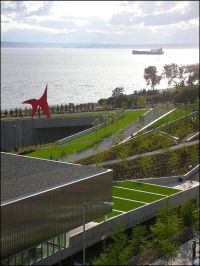
I was staring out the window at the Olympic Sculpture Park‘s beautiful landscape when, about 30 minutes into a panel discussion about art and the environment, moderator Lucia Athens finally mentioned the elephant in the room — or rather, the sacred cow.
It came in the form of a question thrown out to the panelists — architect Tom Kundig, style expert Rebecca Luke, and artist Roy McMakin — about a new bill that would cut the money funneled to public art projects (about one-half of one percent of state building funds). Proposed by Washington Sen. Steve Hobbs (D-Lake Stevens), who has said he considers public art to be a "sacred cow that should be put out to pasture," the bill would save the state $5 million in the next budget.
"Absurd" was Kundig’s response. Stand back and look at the proportion, he advised; this bill doesn’t look at the big picture of how much money is put toward other, more wasteful projects.
It’s not just about the money, McMakin said. Public art is about culture, and it’s about jobs. "Art is woven into the culture of the built environment around us."
Why should you care about this public art battle?
Because, as Cascade Land Conservancy President Gene Duvernoy said during a similar discussion last summer, "Cities are what’s going to get us out of this mess … and what makes cities livable is art."
Echoing that, Kundig said later during the discussion that as an architect he feels it’s his job and the job of artists to make a dense city environment a wonderful place to live.
But are sustainability, cost, and aesthetics competing priorities? No, says Luke, co-founder of the Sustainable Style Foundation, less is more. "It’s all intrinsic in making people feel good about what they’re wearing."
All three panelists spoke to the "less is more" theme, emphasizing the importance of "producing an enduring experience" — whether it be McMakin’s long-lasting furniture pieces, Kundig’s self-sustaining cabins, or Luke’s focus on fashion that stands the test of time.
The panelists also offered suggestions for how the city can nurture sustainable design. Kundig said he thinks it’s up to the private sector because that’s where most of his green-minded client base comes from. Luke’s suggestion focused on small biz folk: She said Seattle needs more affordable leases downtown and zoning laws that allow those small, sustainable businesses to flourish.
McMakin offered up taxes as a solution, saying money should be put toward public infrastructure for green projects. Although he acknowledged that people don’t like to tax themselves, perhaps the recent vote on the Pike Place Market and Parks levies indicates Seattle has a charitable streak.
Which leads me to one last question, Seattle: Won’t you spare some change for a starving artist?


